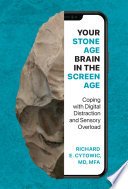

One of the central themes of the book is the concept of evolutionary mismatch, which refers to the gap between our ancient brain's design and the modern world we inhabit. Our brains evolved in a vastly different environment, characterized by survival needs, social interactions, and physical challenges. In contrast, today's digital age presents stimuli that our ancestors never faced, such as constant notifications, social media pressures, and information overload. This mismatch can lead to stress, anxiety, and diminished attention spans. The author argues that understanding this mismatch is crucial for navigating the digital landscape effectively. By recognizing the ways in which our Stone Age brains respond to modern stimuli, we can develop strategies to mitigate the negative impacts of technology on our mental well-being.
Continue readingThe book delves into the issue of cognitive overload, which is exacerbated by the digital environment. With the abundance of information available at our fingertips, our brains struggle to process and prioritize what is important. Cognitive overload can lead to decreased productivity, poor decision-making, and increased stress levels. The author emphasizes the importance of digital detoxes and intentional breaks from technology to help our brains reset and regain focus. Techniques such as time-blocking, mindful consumption of information, and setting boundaries around technology use are suggested as ways to combat cognitive overload and enhance our cognitive capacity.
Continue readingAnother significant idea presented in the book is the impact of social media on mental health. The author discusses how platforms designed for social connection can paradoxically lead to feelings of isolation and inadequacy. The constant comparison to curated online personas can create unrealistic expectations and diminish self-esteem. The book encourages readers to critically assess their social media habits, promoting a more mindful approach to online interactions. Strategies such as limiting screen time, curating feeds to include positive influences, and fostering real-life connections are recommended to improve mental health in the age of social media.
Continue readingThe book highlights the concept of the attention economy, where companies compete for our limited attention spans. The author explains how technology is designed to capture and hold our attention, often at the expense of our well-being. This competition for attention can lead to addictive behaviors and a sense of disconnection from the present moment. To counteract this, the book suggests practices such as mindfulness and intentional engagement with technology. By being aware of how our attention is being manipulated, we can take charge of our digital consumption and prioritize activities that enrich our lives.
Continue readingDigital minimalism is presented as a solution to the challenges posed by modern technology. The author advocates for a more intentional and selective approach to technology use, focusing on quality over quantity. By identifying the digital tools and platforms that genuinely add value to our lives, we can eliminate unnecessary distractions and create a more fulfilling digital experience. The book provides practical steps for adopting a digital minimalist lifestyle, including decluttering digital spaces, setting clear goals for technology use, and prioritizing offline activities that foster deeper connections and personal growth.
Continue readingThe book underscores the significance of real-world connections in an increasingly digital world. While technology can facilitate communication, it cannot replace the depth and richness of face-to-face interactions. The author argues that nurturing real-world relationships is essential for emotional well-being and social fulfillment. The book encourages readers to invest time in building and maintaining meaningful connections with family, friends, and community members. Activities such as shared meals, group outings, and community service are suggested as ways to strengthen these bonds and enhance overall life satisfaction.
Continue readingFinally, the book emphasizes the role of mindfulness in navigating technology use. Mindfulness practices can help individuals become more aware of their technology habits, allowing them to make conscious choices rather than reacting impulsively to digital stimuli. The author provides techniques for incorporating mindfulness into daily routines, such as mindful breathing, meditation, and intentional pauses before engaging with technology. By cultivating mindfulness, readers can develop a healthier relationship with technology, leading to improved focus, reduced stress, and greater overall well-being.
Continue reading